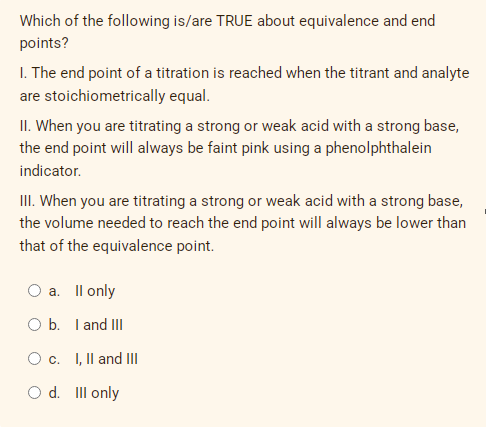points? I. The end point of a titration is reached when the titrant and analyte are stoichiometrically equal. II. When you are titrating a strong or weak acid with a strong base, the end point will always be faint pink using a phenolphthalein indicator. II. When you are titrating a strong or weak acid with a strong base, the volume needed to reach the end point will always be lower than that of the equivalence point. O a. Il only
points? I. The end point of a titration is reached when the titrant and analyte are stoichiometrically equal. II. When you are titrating a strong or weak acid with a strong base, the end point will always be faint pink using a phenolphthalein indicator. II. When you are titrating a strong or weak acid with a strong base, the volume needed to reach the end point will always be lower than that of the equivalence point. O a. Il only
Chemistry: The Molecular Science
5th Edition
ISBN:9781285199047
Author:John W. Moore, Conrad L. Stanitski
Publisher:John W. Moore, Conrad L. Stanitski
Chapter15: Additional Aqueous Equilibria
Section: Chapter Questions
Problem 34QRT
Related questions
Question
[4] please help answer and show solution/explanation.

Transcribed Image Text:Which of the following is/are TRUE about equivalence and end
points?
I. The end point of a titration is reached when the titrant and analyte
are stoichiometrically equal.
II. When you are titrating a strong or weak acid with a strong base,
the end point will always be faint pink using a phenolphthalein
indicator.
III. When you are titrating a strong or weak acid with a strong base,
the volume needed to reach the end point will always be lower than
that of the equivalence point.
a. Il only
O b. I and II
O c. I, Il and II
O d. II only
Expert Solution
This question has been solved!
Explore an expertly crafted, step-by-step solution for a thorough understanding of key concepts.
Step by step
Solved in 2 steps

Knowledge Booster
Learn more about
Need a deep-dive on the concept behind this application? Look no further. Learn more about this topic, chemistry and related others by exploring similar questions and additional content below.Recommended textbooks for you

Chemistry: The Molecular Science
Chemistry
ISBN:
9781285199047
Author:
John W. Moore, Conrad L. Stanitski
Publisher:
Cengage Learning

Chemistry: An Atoms First Approach
Chemistry
ISBN:
9781305079243
Author:
Steven S. Zumdahl, Susan A. Zumdahl
Publisher:
Cengage Learning


Chemistry: The Molecular Science
Chemistry
ISBN:
9781285199047
Author:
John W. Moore, Conrad L. Stanitski
Publisher:
Cengage Learning

Chemistry: An Atoms First Approach
Chemistry
ISBN:
9781305079243
Author:
Steven S. Zumdahl, Susan A. Zumdahl
Publisher:
Cengage Learning


Chemistry
Chemistry
ISBN:
9781305957404
Author:
Steven S. Zumdahl, Susan A. Zumdahl, Donald J. DeCoste
Publisher:
Cengage Learning

Chemistry & Chemical Reactivity
Chemistry
ISBN:
9781337399074
Author:
John C. Kotz, Paul M. Treichel, John Townsend, David Treichel
Publisher:
Cengage Learning

Chemistry & Chemical Reactivity
Chemistry
ISBN:
9781133949640
Author:
John C. Kotz, Paul M. Treichel, John Townsend, David Treichel
Publisher:
Cengage Learning